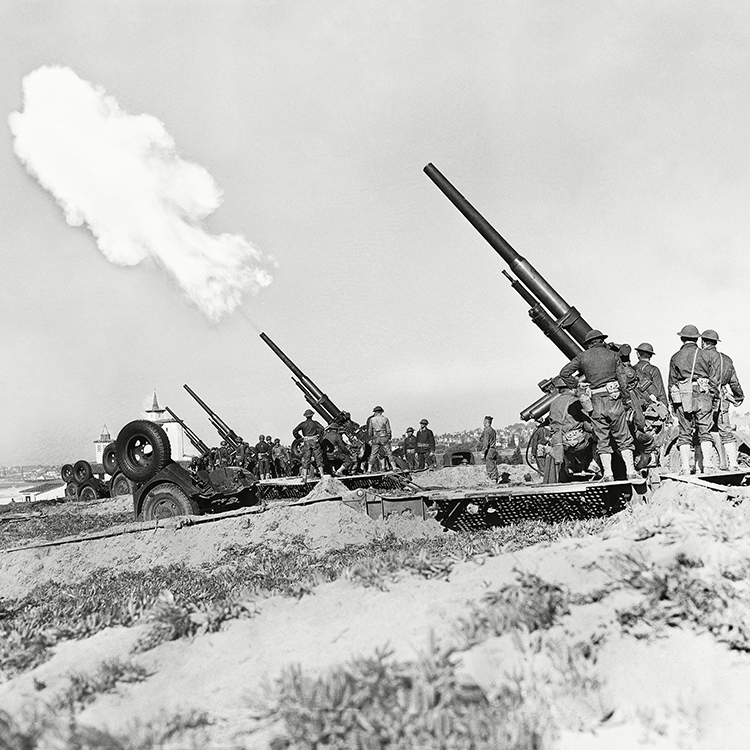Sometimes in warfare it simply doesn’t matter if you have superior numbers, morale, leadership, and courage on your side—if you are up against a new super-weapon you hardly have a hope. A Sumerian with a chariot had a battle-winning weapon; Hannibal had a quite literally elephantine advantage over the Romans when he came down from the Alps; the longbow, the musket, and the bayonet all brought early victories to their inventors when they were first deployed against unsuspecting antagonists.
The excellent 12 Seconds of Silence is about another such world-changing weapon: the proximity fuse. Fortunately, in the Second World War, where it was so desperately needed, it was discovered by the same side that also had superior numbers, morale, and leadership.
Invent As You Go
In this meticulously researched and well-written book, Jamie Holmes argues that the proximity fuse was the world’s first smart weapon, whose value proved momentous in the eventual victory of the Allies over Hitler. U.S. brigadier general Edward Ott claimed it to be “the greatest ever development in field artillery,” and this account of the complex, precarious, and often bizarre history of the fuse’s invention and deployment is a prescient reminder of the role of science in both power and peace.
Holmes rightly notes that the Second World War was the first in history to be decided by weapons which had not been invented at the onset of the conflict; thus, in 1944, after nearly two years at war, the United States was about to engage on a new technological front. The target was the German V-1 flying drone, a 4,900-pound “robot bomb” (the 12-second time lapse in the book’s title being the interval between the drone’s engine shutdown and its explosion). At the start of the war, anti-aircraft equipment had been clumsy at best—Holmes quotes one scientist’s glum observation that “it would be just a sheer stroke of luck to hit anything,” hence in the months before D-day, American science was engaged in a desperate race against Nazi science. Ultimate victory in the air would go to whichever side could out-engineer the other.
The proximity fuse itself was a David to the V-1’s Goliath, a five-pound “marvel of … industry and can-do spirit.” It worked by sending out a radio signal which detected the presence of nearby aircraft. A positive read would set off explosives in the bombshell, releasing a cascade of deadly shrapnel.
Eventually, the U.S. was to successfully manufacture 22 million fuses, at the astronomical cost of more than a billion dollars.
The proximity fuse was a David to the German V-1’s Goliath.
Mr. Holmes has consulted over 5,000 original documents in order to compile his story, and his analysis of these largely fresh primary sources will contribute hugely to our understanding of the key role played by this advanced yet relatively—as compared with the atomic bomb—unsung technology. So much writing on World War II focuses on the vast personalities of the leaders of the Allied and Axis powers—Roosevelt, Churchill, Hitler, Mussolini, Stalin, de Gaulle, and so on—perhaps because psychologizing strategy is more immediately appealing than assessing the nuts-and-bolts value of weapons.
The biographical material in 12 Seconds of Silence, however, is equally as gripping as any study of the period’s more extensively documented characters.
Lighting the Fuse
The two men who spearheaded the research on the proximity fuse, described here as ranking “among the most decisive technological breakthroughs of the war,” both had a certain eccentric genius.

Merle Tuve, a brilliant physicist from a Norwegian-immigrant family, discovered the capacity of radio-wave pulses to echo off the atmosphere (otherwise known as radar) at the age of just 24, while Vannevar Bush, known as the Wizard, president of the Carnegie Institution of Washington, was the most politically influential scientist of his day. Faced with the government’s continuing lassitude in the face of the Nazi technological threat, Bush conceived a radically simple solution: hire the cleverest people and give them authority.
This is the poignant story of his battle to do just that, one that culminated in the confrontation of two secret weapons over mainland Europe in the summer of 1944.
Hire the cleverest people and give them authority.
The quest for the fuse involves a vivid cast of chancers, idealistic scholars, and obdurate military commanders. As the clock ticks down, the conflict between boffins and brass is almost as dramatic as the progress of the war itself. Standing up to Admiral Ernest King, the U.S. naval chief of staff, who claimed that the use of the fuse was a strictly military matter, Bush boldly defended his team at “Section T,” telling King, “It is a combined military and technical question, and on the latter you are a babe in arms and not entitled to an opinion.”
Divisions also emerged between the scientists themselves: Tuve objected to the use of his defensive weapon for offensive purposes, while Bush argued that the fuse would be instrumental in saving the lives of perhaps tens of thousands of American G.I.’s. When the Nazis attacked in the Ardennes in the Battle of the Bulge, in December 1944, the fuse was cleared for immediate use, and in the most devastating aerial battery the Germans had ever encountered, it proved more than 90 percent effective.
The use of the proximity fuse against enemy troops not only decided one of the most crucial phases of the war but undoubtedly saved huge numbers of Allied lives, yet Tuve’s doubts haunted him for the rest of his life. He never visited Germany, he explained in a later interview, because “there are too many orphans there on my account.”
The tight pace and crisp narrative of the book is consistently engaging. Holmes has a wonderful eye for realistic detail, recalling how the sizzle of a frying pan could conceal the approach of a bomber, and his inclusion of hundreds of eyewitness accounts builds a moving picture of daily life amidst the horrors of war. He particularly emphasizes the contribution of women, the extent of whose war work remains as yet insufficiently acknowledged, such as the case of Jeannie Rousseau, a young French linguist who risked her life to provide vital intelligence reports to Section T.
As a British military historian, it gave me no pleasure to learn that after a brief moment of celebration, the achievements of Section T were arrogated by the British to themselves. Several historians have even claimed that we Brits invented the proximity fuse, and merely gave it to Merle Tuve to manufacture. 12 Seconds of Silence not only corrects this egregious error, but stands as an impressive and necessary monument to the spirit and sacrifice of the Americans whose innovation proved so imperative in winning the Second World War.
Andrew Roberts is the author of Churchill: Walking with Destiny


